The most effective remedies for pests: how to treat onions from worms and how to do it correctly
Onions are used to prepare a large number of dishes, so many gardeners grow them in their personal plot. Despite the pungent smell and specific taste, this plant is often affected by various insects. To protect the onions from them and get a good harvest, the soil and plantings are treated with special substances. Whether a turnip can be wormy and how to get rid of pests, we will tell in the article.
The content of the article
What worms threaten onions
Both adult insects and their larvae, which hatch from eggs laid in the soil or on its surface, cause harm to onions. Often, a lesion is detected when the root system has already been damaged. Therefore, you need to know the signs of the appearance pests and their main external characteristics.
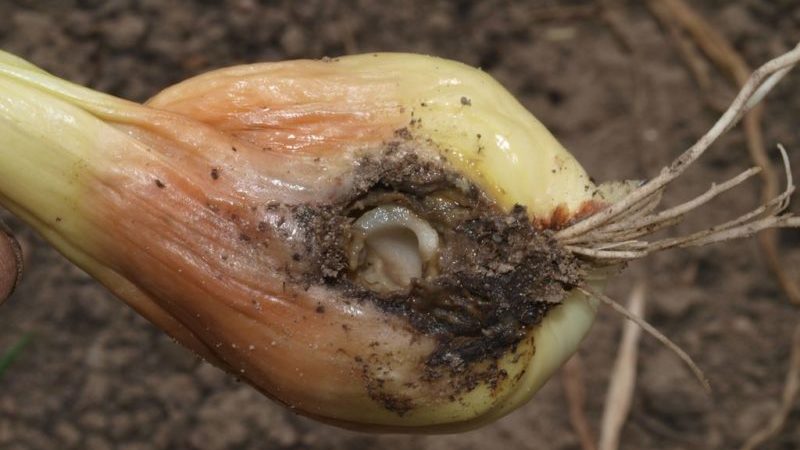
Root mite
This insect settles in the bulb, gradually eating it and leading to rotting. It affects both planting and already harvested crop. The mature specimen reaches 1.1 mm and has a color from white to yellow.
Eggs are oval, white. The female deposits them directly into the root system of the plant. After 2-3 weeks, larvae appear from them. Both adults and young individuals feed on the tissues of the bulb.
Important! Under unfavorable conditions, the root mite falls into a state of suspended animation, but as soon as a favorable environment appears, it is activated again.
Signs of onion root mite damage include:
- mold and rot on the stem and root;
- deformation of the heads;
- yellowing and drying of onion feathers;
- white bloom on the leaves;
- drying and gradual falling off of the roots from the bottom of the bulb.
Onion hoverfly
This insect infects onions in the phase when the heads are already beginning to form. The size of a mature individual reaches 7 mm, outwardly it is very similar to a fly. A distinctive feature is a bronze-greenish color and 2 gray stripes on the back.
In early May, the hoverfly lays eggs on the soil near the plantings, from which, after 5-10 days, worm-like, off-white larvae appear. It is they who feed on the pulp of the onion.
Important! Onion hoverfly larvae hibernate in the ground and, with the onset of heat, turn into pupae, from which adult insects appear in 2-2.5 weeks.
The main signs of a plant lesion with an onion hoverfly include:
- wilting and yellowing of the stems;
- stopping growth;
- softening of the head, blackening of the core;
- with a massive defeat of plantings, the appearance of an unpleasant odor, which accompanies rotting of the bulbs.
Onion fly
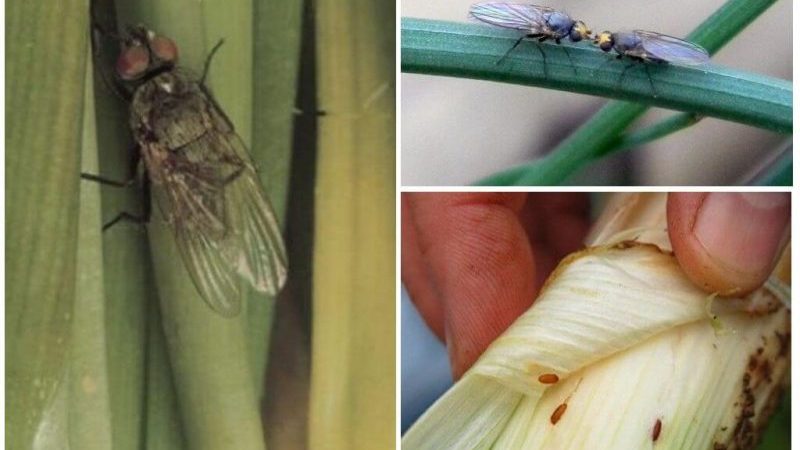
This pest settles in young seedlings and quickly affects all plantings, as it is able to move from a diseased plant to a healthy one. Mature individual onion fly reaches 8 mm, has an ash-gray body color and an oblong yellow wings.
The fly lays white eggs on onion seedlings and in the soil around them. After 3-6 days, off-white larvae appear from them, which settle in the rhizome and feed on it.
Important! The danger of the onion fly lies in the development of several generations per season and its ability to stay in the soil for a long time without a nutrient medium.
The main signs of defeat:
- mass wilting of plantings in the phase of the first leaf;
- the presence of larvae on the soil at the base of the plant;
- small holes in the bulb and feathers;
- rotting of the root system.
Stem nematode
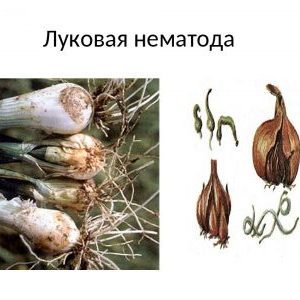
This pest is able to destroy the plant completely in 7-10 days, sucking juice from the leaves and bulb. At the same time, rotting of the root system begins, leading to the death of the seedling.
The mature specimen has a white-yellow threadlike body and reaches a size of 1.5 mm. From very small eggs, invisible to the human eye, after 3-5 days, larvae appear, outwardly similar to adults.
To the symptoms of onion stem damage nematode relate:
- yellowing and gradual drying of feathers;
- softening of the bulbs;
- peeling and cracking of the head surfaces;
- decay of the rhizome;
- falling off roots located at the bottom;
- signs of rotting on the underside of the stem.
The process of forming larvae into an adult capable of reproduction takes 1.5 months.
Onion weevil
This pest destroys the stems of the plant, which negatively affects the development of the head.
The mature specimen reaches a size of 3 mm and has a black color with a white longitudinal stripe on the back. In the first half of May, the insect lays small white eggs (0.5 mm) in the leaves of seedlings. Of these, after 10-14 days, oblong yellow larvae appear.
Onion weevil lesion symptoms:
- suspension of growth;
- yellowing and wilting of arrows;
- irregularities along the edge of the leaves;
- whitish spots and arrows on the stems.
The pest hibernates in the upper layers of the soil and becomes active in mid-April.
Onion moth
The larvae of this insect infect the stems and roots of the plant, leading to its decay and death.
The mature specimen is a small brownish butterfly, reaching 1.5 mm. At the end of May, she lays oval yellow eggs in onion stalks, from which larvae appear after a week. Their length is 1 cm, the color of the body is yellow-green. A distinctive feature is brown warts that completely cover the body of the larva.
Signs of moth infestation include:
- suspension of growth;
- wilting of leaves;
- the appearance of long longitudinal stripes on the stems;
- yellowing and wilting of arrows;
- rotting bulbs.
The second generation of plants appears after 3 weeks, so treatment with drugs must be carried out several times per season.
Thrips
This pest is capable of damaging not only landingbut also the harvest in storage.
The mature specimen reaches 1.3 mm and has a brown or off-yellow color, yellow antennae and red eyes. The insect lays white barrel-shaped eggs in onion stalks. After 4-5 days, white or light yellow larvae appear from them.
Symptoms of onion damage with thrips include:
- suspension of growth;
- change in shape and yellowing of the stems;
- signs of rotting in the entire seedling;
- silvery or white stripes on the leaves;
- small onions.
The second generation of insects develops in about 20 days, so the pesticide treatment is carried out several times per season.
Wireworm
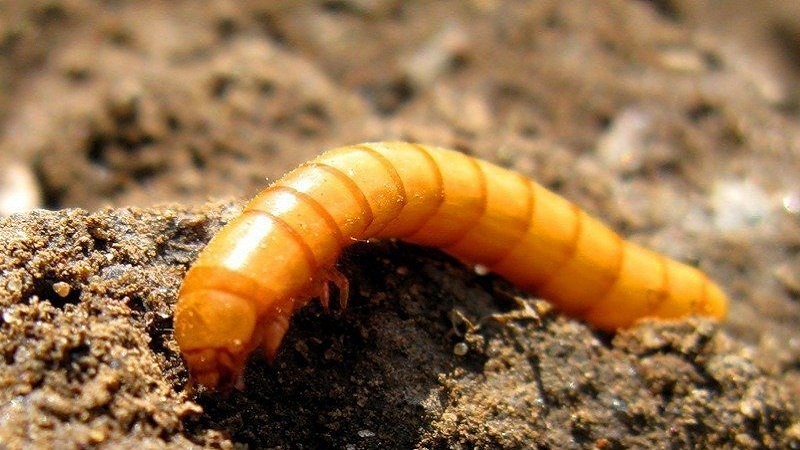
This is a click beetle larva that infects the root of the plant. The wireworm develops for several years, all this time being in the soil and constantly infecting the plantings.
Signs of a wireworm onion damage include:
- drying of plant stems;
- holes in the bulbs.
The clicker beetle is capable of laying larvae on a large number of landings. Timely treatment with special preparations stops its reproduction and destroys all generations of the insect.
Symptoms of onion worm damage
The signs of pests on onion beds are similar. First of all, they appear on the stems of the plant, which turn yellow, mutate and gradually dry out.
Important! Depending on the weather conditions, the damage to the bulbs by the larvae also differs. In the hot period they dry up, in the rainy period they rot.
What to do if white worms eat onions
If an onion is damaged by harmful insects, the diseased plant is immediately removed along with a lump of earth. Then the soil and planting are treated with chemical or biological preparations and folk remedies.
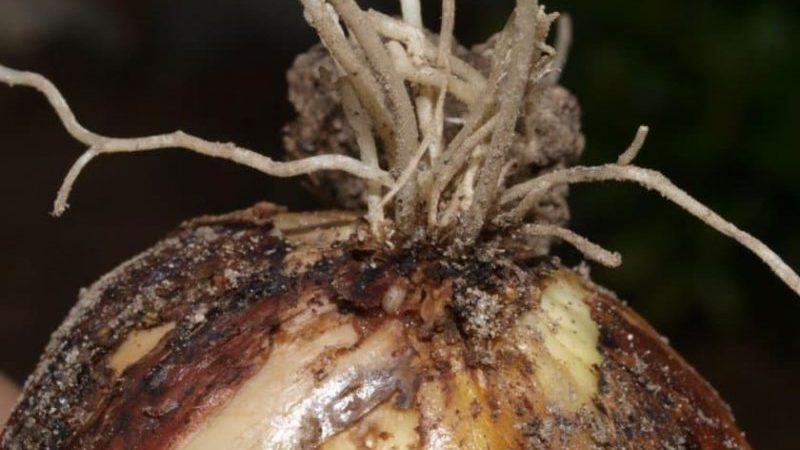
The following agrotechnical methods are also used:
- mustard, marigold, mint, calendula and carrots are planted next to onions, which contain substances that repel pests;
- weed plantings regularly;
- loosen the soil;
- thin out;
- mulch;
- the seedlings are constantly examined;
- observe the watering regime.
All of these actions will help prevent insect infestation on the onion and significantly reduce the spread of pests if they appear.
How to pour onions from worms
All pests that infect onions are equally effective with ready-made purchased preparations and folk remedies. The latter are most often used when less than 2 weeks are left before harvesting, since the chemicals tend to accumulate in the tissues of the plant.
Chemicals
Chemicals are used to destroy pests on young onion seedlings. When growing a plant they are not applied to the pen.
Preparations that are applied to the soil:
- "Mukhoed";
- Zemlin;
- "Medvetox".
These funds are evenly distributed on the surface of the soil, which is then carefully loosened.
For spraying the leaves, drugs are used:
- Fitoverm;
- Iskra DE;
- Sochva.
A prerequisite for the use of chemicals is strict adherence to the instructions indicated on the packaging.
Biological preparations
This type of agent is as effective as chemical preparations, but practically does not accumulate in plant tissues. Therefore, they can be used in any growing season.
How to treat onions from worms:
- "Trichodermin". To prepare the product, 30 g of the drug is diluted in 30 liters of water.
- "Metronidazole". 4 tablets are diluted in 10 liters of water and the plantings are sprayed.
Folk remedies
Folk remedies for onion pests will not only destroy all generations of insects, but also saturate plants with nutrients.
Important! Processing plantings with folk remedies is carried out 3 times per season, taking breaks between them for at least 2 weeks.
The most effective are:
- Ash. In 10 liters of water, 100 g of the product are diluted and the plants are sprayed.
- Dandelion decoction. 200 g of flowers are brewed in 1 liter of water and insisted for 2-3 days. The concentrate is diluted in 10 liters of water and the planting is sprayed.
- Soap. In 10 liters of warm water, dissolve 200 g of shavings of laundry soap. The soil is poured with the solution and the seedlings are sprayed.
- Salt. In 10 liters of water dissolve 300 g of table salt and watered with onion beds.
How to process correctly
Compliance with the rules for processing onions is a guarantee of complete disposal of plantings from pests. The preparations are introduced into the soil after evening watering at the rate of 1 liter per 1 bush, after which deep loosening is required. This facilitates the penetration of active ingredients to the root of the plant.
Spraying onions with solutions is carried out in calm dry weather 2 times per season with a break of 1.5 weeks at the rate of 4-6 liters per 1 m².
How to process onions to prevent the appearance of worms
So that insects do not start in onion plantings, the seed is soaked in a weak solution of potassium permanganate. Then the seeds are thoroughly dried and planted in pre-prepared soil.
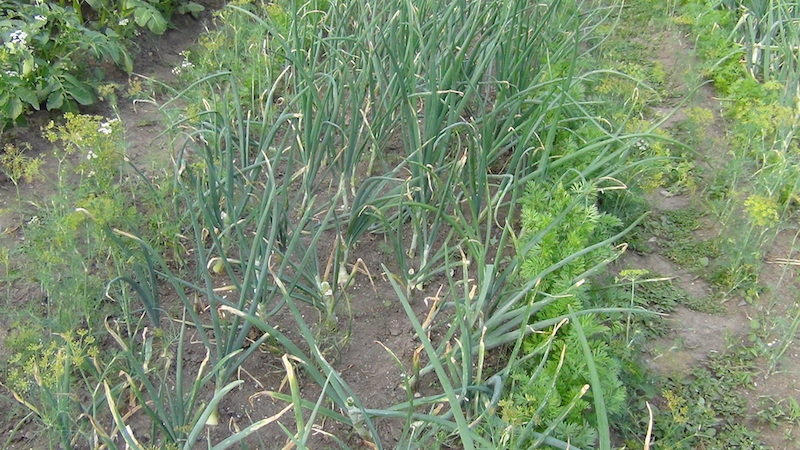
Land cultivation before planting onions
Proper soil treatment will help prevent pests from infesting onion plantings. To do this, perform a number of actions:
- in the fall, they dig up the beds, plunging a shovel into the ground on a full bayonet;
- in the spring, 2 weeks before planting, 300 g of lime per 1 m² and 20 g of ammonium nitrate per 1 m² are introduced into the soil;
- after planting seedlings, the soil is sprinkled with 1 tbsp. l. wood ash per 1 m².
After watering, they must loosen the soil, since in conditions of high humidity, the larvae spread faster.
Tips on the topic
Experienced gardeners use effective methods to protect onion plantings from harmful insects. These include:
- disinfection of seed with a weak solution of potassium permanganate;
- compliance with crop rotation (you cannot plant onions in the same place for 2 years in a row);
- destruction of weeds and tops after harvest;
- pouring chalk powder on the onion before storing it.
Conclusion
To protect onion seedlings from pests, it is important to follow the planting scheme, watering regime, and treat the seed and soil with special means. With early detection, insect larvae can be completely destroyed.